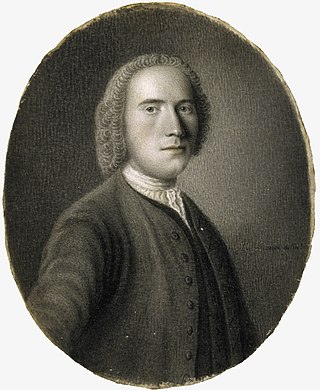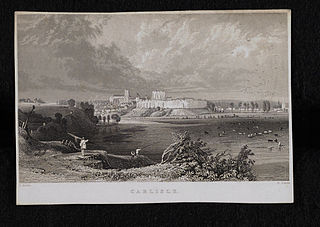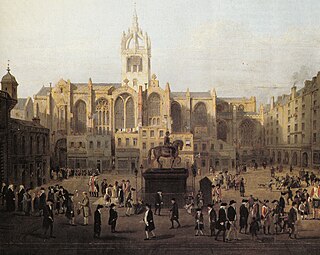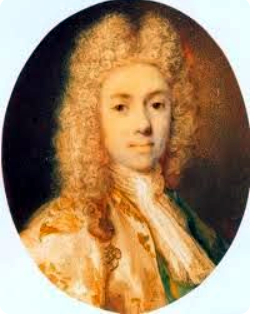Notes
- ↑ Albert Nicholson, ‘Ray, James (fl. 1745–1746)’, rev. Eirwen E. C. Nicholson, Oxford Dictionary of National Biography, Oxford University Press, 2004, accessed 5 July 2009.
James Ray was an English volunteer in the Hanovarian army, most notable for his chronicle of the Jacobite rebellion of 1745, A Complete History of the Rebellion in 1745: From its first rise, in 1745, to its total suppression at the glorious battle of Culloden, in April 1746 (1749, printed by John Jackson, Petergate, York).
Ray was born in Whitehaven, Cumberland. He marched to join the royal garrison at Carlisle in the autumn of 1745 at the time when Charles Edward Stuart's army was marching from Edinburgh. However Carlisle surrendered to the Jacobites before Ray reached the city, and Ray followed the Jacobite army to Derby. The information he gleaned from this expedition he reported to the Duke of Cumberland, whose forces he met at Stafford on 5 January 1746 and with whom he stayed until the Jacobite forces were finally defeated at Culloden in April.
Ray published The acts of the rebels, written by an Egyptian in 1746 and his history of the Jacobite rebellion in 1749. [1]

The Battle of Culloden was the final confrontation of the Jacobite rising of 1745. On 16 April 1746, the Jacobite army of Charles Edward Stuart was decisively defeated by a British government force under Prince William Augustus, Duke of Cumberland, on Drummossie Moor near Inverness in the Scottish Highlands. It was the last pitched battle fought on British soil.

Prince William Augustus, Duke of Cumberland was the third and youngest son of King George II of Great Britain and Ireland and his wife, Caroline of Ansbach. He was Duke of Cumberland from 1726. He is best remembered for his role in putting down the Jacobite Rising at the Battle of Culloden in 1746, which made him immensely popular throughout parts of Britain. He is often referred to by the nickname given to him by his Tory opponents: 'Butcher' Cumberland.

Field Marshal Studholme Hodgson was a British Army officer who served during the 18th century. After serving as an Aide-de-Camp to the Duke of Cumberland at the Battle of Fontenoy during the War of the Austrian Succession and at the Battle of Culloden during the Jacobite Rebellion, he became correspondent to William Barrington, the Secretary at War, during the French and Indian War. He went on to command the British expedition which captured Belle Île in June 1761 during the Seven Years' War so enabling the British Government to use the island as a bargaining piece during the negotiations leading up to the Treaty of Paris in 1763.

The Battle of Prestonpans, also known as the Battle of Gladsmuir, was fought on 21 September 1745, near Prestonpans, in East Lothian, the first significant engagement of the Jacobite rising of 1745.

The Battle of Falkirk Muir, also known as the Battle of Falkirk, took place on 17 January 1746 during the Jacobite rising of 1745. Although it resulted in a Jacobite victory, their inability to take advantage meant it ultimately had little impact on the campaign.

William Boyd, 4th Earl of Kilmarnock, was a Scottish peer who joined the 1745 Jacobite Rising, was captured at Culloden and subsequently executed for treason on Tower Hill.

Lord George Murray, sixth son of John Murray, 1st Duke of Atholl, was a Scottish nobleman and soldier who took part in the Jacobite rebellions of 1715 and 1719 and played a senior role in that of 1745.

The siege of Carlisle took place from 21 to 30 December during the Jacobite rising of 1745, when a Jacobite garrison surrendered to government forces led by the Duke of Cumberland.

William Drummond, 4th Viscount Strathallan, was a Scottish peer and Jacobite, who died at the Battle of Culloden.

The siege of Fort William took place in the Scottish Highlands during the 1745 Jacobite Rising, from 20 March to 3 April 1746.

James Johnstone, also known as Chevalier de Johnstone or Johnstone de Moffatt, was the son of an Edinburgh merchant. He escaped to France after participating in the 1745 Rising; in 1750, he was commissioned in the colonial army and served in French North America.

Lieutenant General John Huske was a British military officer whose active service began in 1707 during the War of the Spanish Succession and ended in 1748.

The Jacobite rising of 1745, also known as the Forty-five Rebellion or simply the '45, was an attempt by Charles Edward Stuart to regain the British throne for his father, James Francis Edward Stuart. It took place during the War of the Austrian Succession, when the bulk of the British Army was fighting in mainland Europe, and proved to be the last in a series of revolts that began in March 1689, with major outbreaks in 1708, 1715 and 1719.

The Manchester Regiment was a Jacobite unit raised during the 1745 Rebellion and the only significant number of English recruits willing to fight for Charles Edward Stuart in his attempt to regain the British throne for his father. Raised in late November 1745, the majority were captured in December at Carlisle; eleven officers and sixteen members of the rank and file were executed in 1746, over a quarter of all those executed for their role in the Rising.

Sir John William O'Sullivan was an Irish professional soldier, who spent most of his career in the service of France, but is best known for his involvement in the Jacobite rising of 1745, an attempt to regain the British throne for the exiled House of Stuart. During the Rising, he acted as adjutant general and quartermaster general of the Jacobite army and had a major influence on the campaign.

William Murray, Marquess of Tullibardine was a Scottish nobleman and Jacobite who took part in the rebellions of 1715, 1719, and 1745.

The siege of Stirling Castle took place from 8 January to 1 February 1746, during the 1745 Rising, when a Jacobite force besieged Stirling Castle, held by a government garrison under William Blakeney.

The Seven Men of Moidart, in Jacobite folklore, were seven followers of Charles Edward Stuart who accompanied him at the start of his 1745 attempt to reclaim the thrones of Great Britain and Ireland for the House of Stuart. The group included English, Scots and Irish subjects of varying backgrounds linked mostly by their involvement in pro-Stuart intrigues. Although some had military experience, most of the men were relatively elderly by the standards of the time; some were already infirm and little suited to the rigours of campaigning.
Lieutenant-Colonel Caroline Frederick Scott was a Scottish soldier and military engineer who served in the British Army before transferring to the East India Company.

An Incident in the Rebellion of 1745 is an oil painting, by the Anglo-Swiss artist David Morier. It is part of the art collection of the British royal family. The painting depicts a scene during the 1746 Battle of Culloden, in which a group of Jacobite Army troops charge against a line of government soldiers.